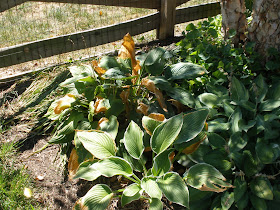But today I am simply a gardener who at 2:45 pm is still in her pajama shorts enjoying a very quiet day at home. I spent part of the morning wandering around in the garden (in my pajama shorts) and despite several weeks of high heat and no rain, beauty abounded. Here's what I saw:
This is agastache 'Shades of Orange' from High Country Gardens. It loves the heat and doesn't want much extra water. It's much loved by the hummingbirds.
I love peachy orange flowers. When I look out my kitchen window and see this plant in bloom, it's like having a constant sunrise in the garden.
This caryopteris (Blue Mist Spirea) is supposed to be a dwarf cultivar. However, it's huge and has been in a shoving match all summer with a nearby sweetspire. I finally intervened and cut back the sweetspire a bit to give the caryopteris more room. It's been covered with bees since it started blooming.
Phlox 'Delta Snow' has bloomed almost all summer. It stands stalwart under a crepe myrtle, overshadowing it's cousin 'Nicky', enjoying the shade, and growing taller every year.
The bees and skippers busily canvas the sedum even before the blooms open. This is planted near several large trees that contiually rob the soil of nutrients and moisture. On my fall to-do list: compost, compost, compost!!!
I've had so many monarch caterpillars on my bloodflower (Tropical milkweed) that every leaf is gone. I hope the new growth grows fast enough to nuture and feed a few more!
My father in law calls my chenille plant "caterpillar plant" even though it doesn't attract any caterpillars. It was one of the few plants, along with my rue, that survived the horrific spider mite infestation that destroyed several of my potted plants. No amount of blasting from the hose could get rid of them. I plant it in a pot with my rosemary every summer. It doesn't attract any wildlife but it does attract me, so that's good enough!!
Bird seed sunflowers under the platform feeder and verbena bonariensis. The trumpet creeper, giant hog of all moisture and fertility, is off to the left.
This section of the garden is, as we used to say when I lived in the south, a hot mess! I've tried for years to make this a low-fertility, xeric garden bed, but my plants have decided that I'M NUTS!! They would like more compost, please!! This fall I'm planning on digging up the entire 18 ft bed, which includes two small serviceberry trees, raising the soil height by about 5-6 inches with compost and peat moss, and then rearranging most of the plants. Not an easy job. My very strong 6'5" 18 yr old is going to help me, he just doesn't know it yet... He no help me. I no feed him...!!
My gomphrena are so extremely pot bound that they've become a bit anemic but are still beatiful enough to make me stop in my tracks when I saw them hanging out with the yellow lantana. I have a wonderful surprise planned for them: worm juice from my compost bin added to their daily bucket of water tonight. Yum!!
Sorry hostas!! No water for you till it rains!! I finally figured out what was wrong with my hideous heap of siberian iris: not enough moisture or sun. Plus they probably need to be divided. I already have their new home mapped out for them. I hope they're happy.












How do you make your worm compost tea?
ReplyDeleteI sure see the benefits in my garden and encourage people in my worm classes to make compost tea to make the castings go further
Hi Big Tex! I just take some of the liquid that collects in the bottom of my worm bins (multi-story worm chalets) and pour it into a big 2 gallon watering can. I let it sit for a few hours, or not at all, and then water my plants with it. They realy love it! If I have a lot of liquid, I'll pour it into a rain barrel that's only half full (about 25 gallons out of a 50 gallon capacity) and slowly use it over several days. It's awesome!!! WORMS ROCK!!!!
ReplyDeleteHope you had a good first day of science. That cartoon is funny! I like the chenille plant and I'm going to have to remember that for next spring. Also, good for you...having them write sentences! :)
ReplyDeleteThanks Amy! The kids look at me like I have squids coming out of my ears when I explain the sentence rule but they all survive!! Chenille plant is really cool! It might even overwinter for you since you're part of the world is so warm. :0)
ReplyDeleteYou cracked me up with this post. I love the comment about feeding (or possibly not) your son. It has always been my dream to grow Hostas, but I have yet to try. So Cal is probably not the best location for them.
ReplyDeleteMaybe I would have liked science more if you were my teacher. Lucky students!
Thanks KJ! Hostas are pretty tough but I'm not sure if they grow in semi-tropical climates. As for my son... I once advised him to always play nice to the people who shelter, clothe, and feed you. He took the hint and voila! I have an assistant! I'm sure he's thrilled! :0)
ReplyDelete